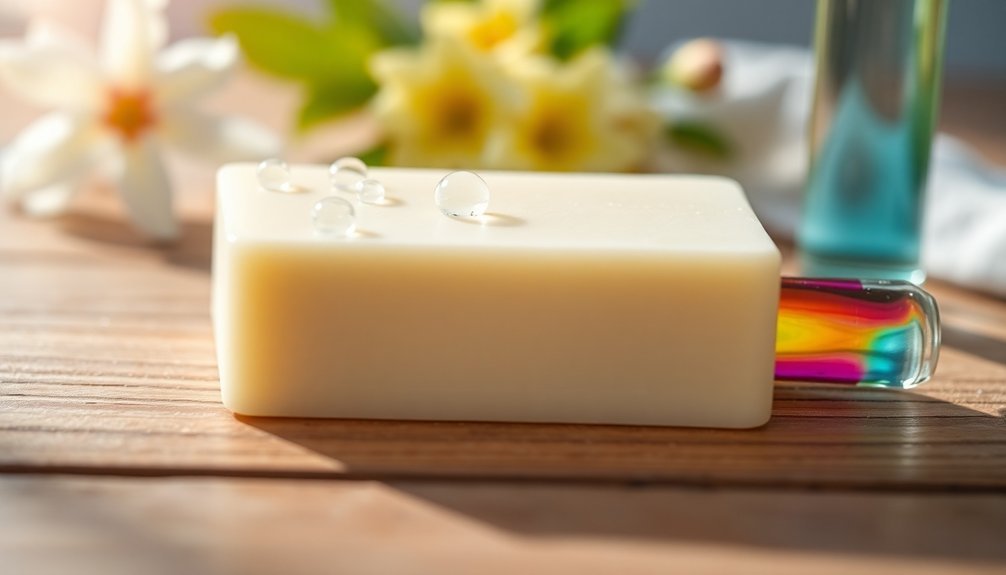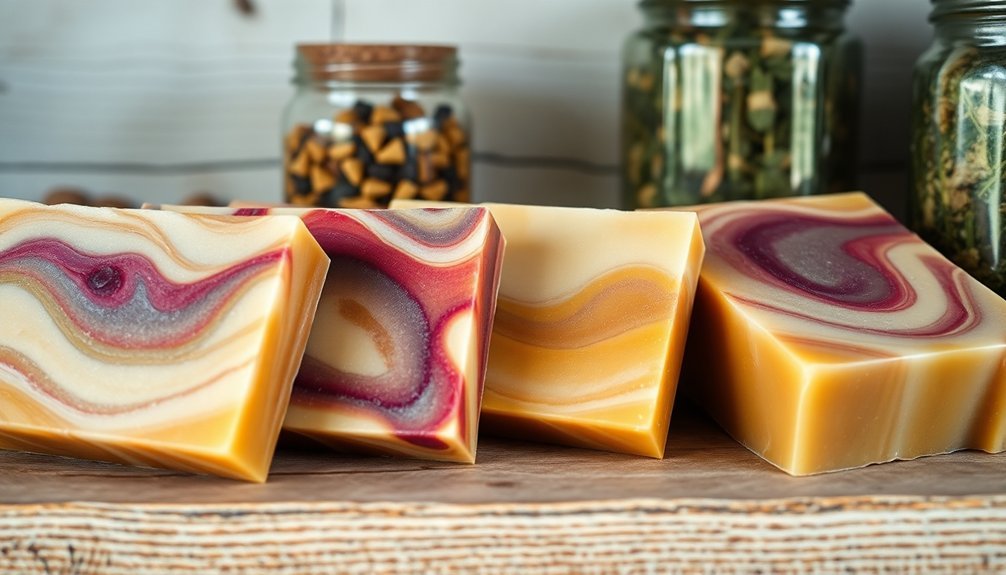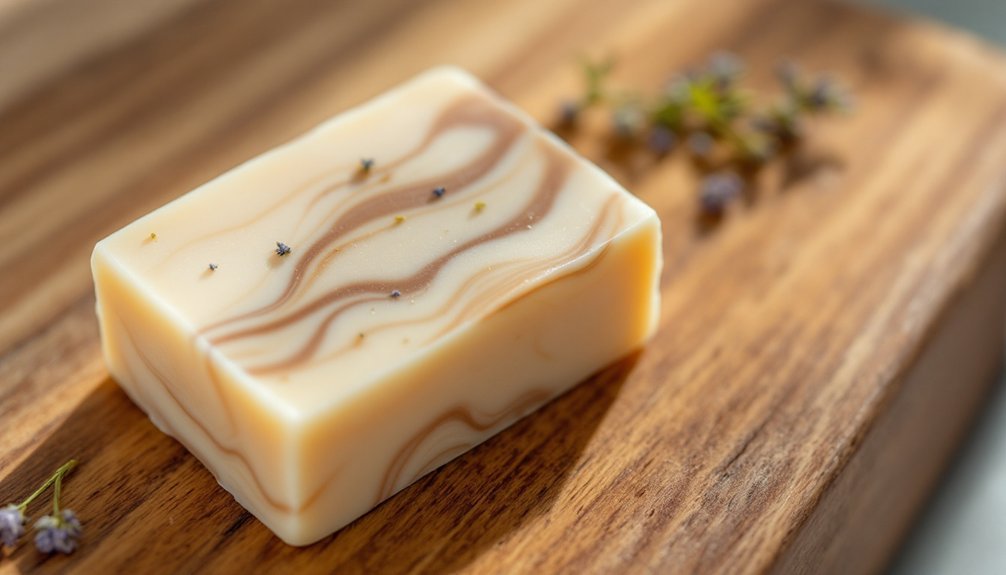High-quality natural soap contains at least 95% natural ingredients with plant-based oils and essential oils for fragrance. You'll recognize premium bars by their proper 4-6 week curing process, skin-compatible pH levels, and rich, stable lather. The best artisans guarantee transparency through full INCI ingredient disclosure and may have third-party certifications. Well-made natural soaps last about a year when stored properly—far longer than liquid alternatives. Discover what proper preservation techniques can do for your skincare routine.
Precise Ingredient Purity Standards

When crafting high-quality natural soap, adherence to precise ingredient purity standards isn't merely optional—it's essential. The Natural Products Association requires products labeled "natural" to contain at least 95% natural ingredients, excluding water.
You'll want to avoid soaps containing synthetic preservatives, silicones, ethoxylates, or petroleum-derived fragrances. High-quality natural soaps use plant-based oils like olive and coconut, essential oils for fragrance, and natural colorants and exfoliants.
Check that manufacturers fully disclose all ingredients using INCI nomenclature. While sodium hydroxide is necessary for saponification, all other components should be biodegradable and environmentally friendly. The proper curing process ensures no residual lye remains in the finished soap, resulting in a gentle, skin-safe product.
Third-party certification from organizations like the NPA can verify these standards, giving you confidence in your soap's purity and quality.
Manual Curing Time and Hardness Evaluation
The science of soap making extends beyond ingredient selection to the critical process of curing. Quality natural soaps require 4-6 weeks of patience as water evaporates and saponification completes. This transforms your soap into a harder, longer-lasting bar with superior lather.
The art of patience in soap making: time transforms your ingredients from mere mixture to masterpiece.
You'll know your soap has properly cured through these indicators:
- Weight stabilization – Regular weighing shows when moisture loss has completed
- Tactile firmness – Fully cured soap feels solid and resistant to pressure
- Visual density – The soap appears more compact than when freshly made
- Enhanced performance – Proper curing creates a bar that lathers well and doesn't dissolve quickly
Environmental factors like humidity and recipe variations affect curing time, with olive oil soaps often benefiting from extended curing periods. Storing your curing soap on a wire rack promotes optimal airflow around each bar, ensuring even drying throughout the curing process.
Ph Testing for Skin Compatibility

Understanding your soap's pH level provides essential insight into its skin compatibility. Your skin maintains a natural acid mantle with pH between 4.5 and 6.2, which protects against bacteria and maintains hydration.
High-quality soapmakers test their products using pH meters for accuracy rather than simple test strips. Natural soaps tend to be slightly alkaline due to the saponification process, while synthetic formulations can be specifically pH-balanced. After using natural soap, your skin typically normalizes after 90 minutes, returning to its ideal pH level.
When a soap's pH aligns with your skin's natural level, you'll experience less irritation, better moisture retention, and a stronger skin barrier. This is particularly important if you have sensitive skin.
Despite marketing claims about "pH-balanced" products, no standardized regulations exist. Quality artisans will transparently share their pH testing results and formulate their soaps to minimize disruption to your skin's natural balance.
Lather Quality and Cleansing Effectiveness
Quality lather indicates much more than just aesthetic appeal in natural soap—it directly reveals both cleansing power and ingredient composition. Your soap's performance depends largely on the oils selected and their proportions in the formula.
Lather quality reveals the soap's true character—a direct reflection of its carefully balanced oil formulation and cleansing capabilities.
Coconut oil creates abundant bubbles due to its high lauric acid content, while castor oil stabilizes lather and adds silkiness. Tight packing of these bubbles produces thick foam when the soap is rubbed between your hands.
For ideal cleansing effectiveness, you'll want to understand:
- Balanced oil combinations (like coconut/palm or castor/olive) produce superior lather stability
- Lower superfat percentages improve lather production without compromising skin benefits
- Natural additives such as sugar or beer can greatly boost bubbliness
- Essential oils contribute antibacterial properties while enhancing the cleansing experience
The best natural soaps achieve the perfect balance between effective cleansing and nourishing skin-friendly properties through thoughtful ingredient selection.
Shelf Life and Natural Preservation Methods

Natural soap's shelf life extends considerably when you employ proper preservation techniques, despite lacking the synthetic preservatives found in commercial products. Quality natural soap typically lasts about one year, though this varies based on ingredients and storage conditions.
You'll maximize longevity by storing your bars in cool, dark places away from moisture. Use breathable packaging and soap dishes with good drainage to prevent water accumulation between uses. Handmade natural soaps can last six times longer than liquid soap alternatives with proper care.
Wrapping unused soap in breathable materials also maintains freshness. Be aware that essential oils may fade in scent over time, and natural colorants might change appearance.
Unlike traditional soaps with synthetic chemicals, natural soap's biodegradable ingredients are gentler on skin while being environmentally friendly. The superfatting process adds extra moisturizing oils, though it slightly reduces shelf life compared to conventional alternatives.
Frequently Asked Questions
How Can I Identify a Genuine Natural Soap From Mass-Produced Options?
You can identify genuine natural soap by checking for recognizable oils, absence of sulfates and parabens, retention of glycerin, essential oil fragrances, and transparent labeling. Small-batch production often signals authenticity too.
Do Natural Soaps Work Effectively in Hard Water Conditions?
Yes, natural soaps can work effectively in hard water. You'll get better results with formulations containing sodium citrate or those that are superfatted. Their moisturizing properties help counteract the drying effects of mineral-rich water.
Can Natural Soaps Help With Specific Skin Conditions Like Psoriasis?
Yes, natural soaps can help with your psoriasis. Those containing pine tar provide antibacterial and antifungal benefits, while shea butter moisturizes and heals your skin. Many also include calming botanicals like lavender to soothe irritation.
What's the Environmental Impact of Essential Oils in Natural Soaps?
Essential oils in your soap cause significant environmental harm through intensive extraction, habitat disruption, and high resource use. They're often not biodegradable and don't retain benefits in soap. Consider unscented options or sustainable alternatives instead.
How Do Seasonal Changes Affect Natural Soap Ingredients and Performance?
Seasons affect your natural soap experience considerably. You'll notice winter soaps contain more moisturizing oils, while summer formulations dry faster. Essential oil blends change too—warming scents in cold months, lighter fragrances during summer.
In Summary
You'll find that high-quality natural soap meets strict ingredient purity standards and undergoes proper manual curing. It's tested for skin-compatible pH levels and delivers excellent lather while cleansing effectively. When you're selecting natural soap, look for products with thoughtful preservation methods that extend shelf life without harmful additives. These quality indicators guarantee you're getting a truly superior natural soap experience.





Leave a Reply